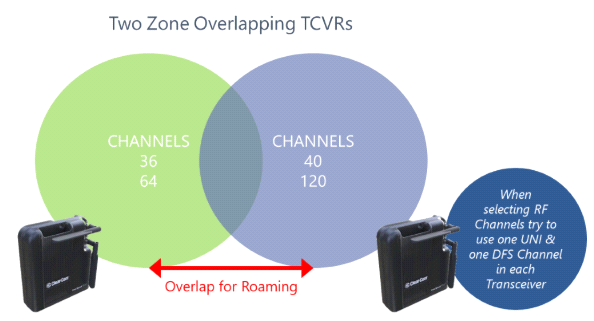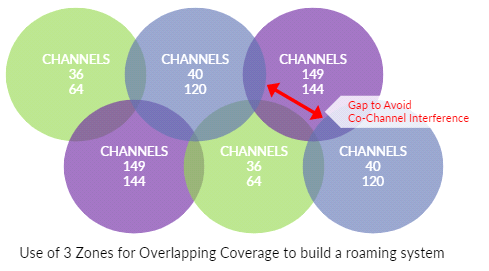RF channel selection 5 GHz
The 5 GHz RF band has a number of regional regulatory variations that need to be taken into account when planning which channels to use:
- Which channels are available in a particular region
- Power regulations
- Availability of channels for outdoor or indoor use
- Availability of channels for universal use.These are the Industrial, Scientific and Medical (ISM) channels. Wi-fi and other 5 GHz devices such as cameras may be using these channels already.
- Channels used for radar (weather and emergency services) communication. These are the Dynamic Frequency Selection (DFS) channels.
As required by law, the regulations and regional variations are automatically enforced by the system software.
Each Edge transceiver uses 2 RF channels at any one time, unless it is using DFS channels, in which case each transceiver makes use of 3 RF channels.
Transceivers use DFS channels by default (when these are available in a particular region) as these are less likely than universal channels to be hosting other traffic. When configured to DFS channels, the transceiver always uses a 3rd backup channel. The backup channel is used if radar or other activity is detected in a channel; the Edge signal will automatically be moved to the backup channel. You will see a double red flash on the transceiver status LEDs when the backup channel is in use. There is also a visual indication in the device configuration software.
When using FreeSpeak Edge, the channels are selected automatically by the host system software in the first instance. The system will automatically allocate channels according to region. It will also select channels that enforce RF spacing between transceivers, as transceivers should not be too close to each other in this respect.
For rapid set up you can use the default channels, but in any case you are advised to seek information about existing 5 GHz traffic in your location. This information can be obtained from:
- A site frequency coordinator or IT administrator (if there is one)
- A scan of channels in the location using the beltpack
Typically, the default channel setup will work for a small system (4 transceivers or less) in an environment that has limited equipment competing for the band usage. For a larger system, or one where there is more 5 GHz traffic, you are advised to take control of transceiver channel selection yourself. RF channels on each transceiver can be changed in the system configuration software (CCM).
Given that each transceiver makes use of at least two channels, a system consisting of 4 transceivers can make use of up to 8 channels. If you are using DFS channels you will also need to take account of backup channels. If this number of channels is not available, channels can be re-used on the location. When re-using channels, you must be careful that transceivers using the same channels are not located next to each other as this causes interference. A beltpack must not be able to see a particular channel more than once at any time.
| Note: | There are many variables that can contribute to interference between channels. For example; installation site infrastructure, channel power setting and physical distance between transcievers. Depending on the install environment, be aware that adjacent channels on adjacent transceivers brings the possibility of interference. The site survery utility found in the beltpack menu system will indicate the possibility of inter-channel interference with a red dot. |
Two transceivers, 4 channels:
Eight transceivers, 6 channels:
The transceivers have selectable power settings, and these can be used to customize the size of an RF cell to suit your environment and avoid the possibility of channels being placed next to each other in the overall coverage zone.
In most countries, 5GHz channels fall into the following categories:
| Channel type | Restrictions |
|---|---|
| ISM (Industrial, scientific and medical) | These are the channels with the least restrictions and highest allowance for transmission power. However, they may be crowded with interference since ISM channels are equally the first choice for other wireless equipment. Also, generic ISM channels don’t exist in some countries (for example. Japan). |
| TPC (transmit power control) | Transmission power is restricted in these channels. The maximum power setting for the FreeSpeak Edge system is below the TPC values in any region. |
| Indoor Channels | If these channels are used, the equipment may only operate in an indoor setting. Different countries have different definitions and requirements for indoor settings. |
| DFS (dynamic frequency selection) | Devices operating in this channel are required to implement a radar detection mechanism and move to a different channel when radar pulses are detected. |
| SRD (short range device) | SRD channels have a power restriction and therefore should only be used if you intend to use a low power setting on a transciever. Different countries have different definitions and requirements for short range device settings. |
For detailed information on regional variations and channel setup see : The RF Configuration Guide, available from the Clear-Com FreeSpeak Edge Knowledge Center.